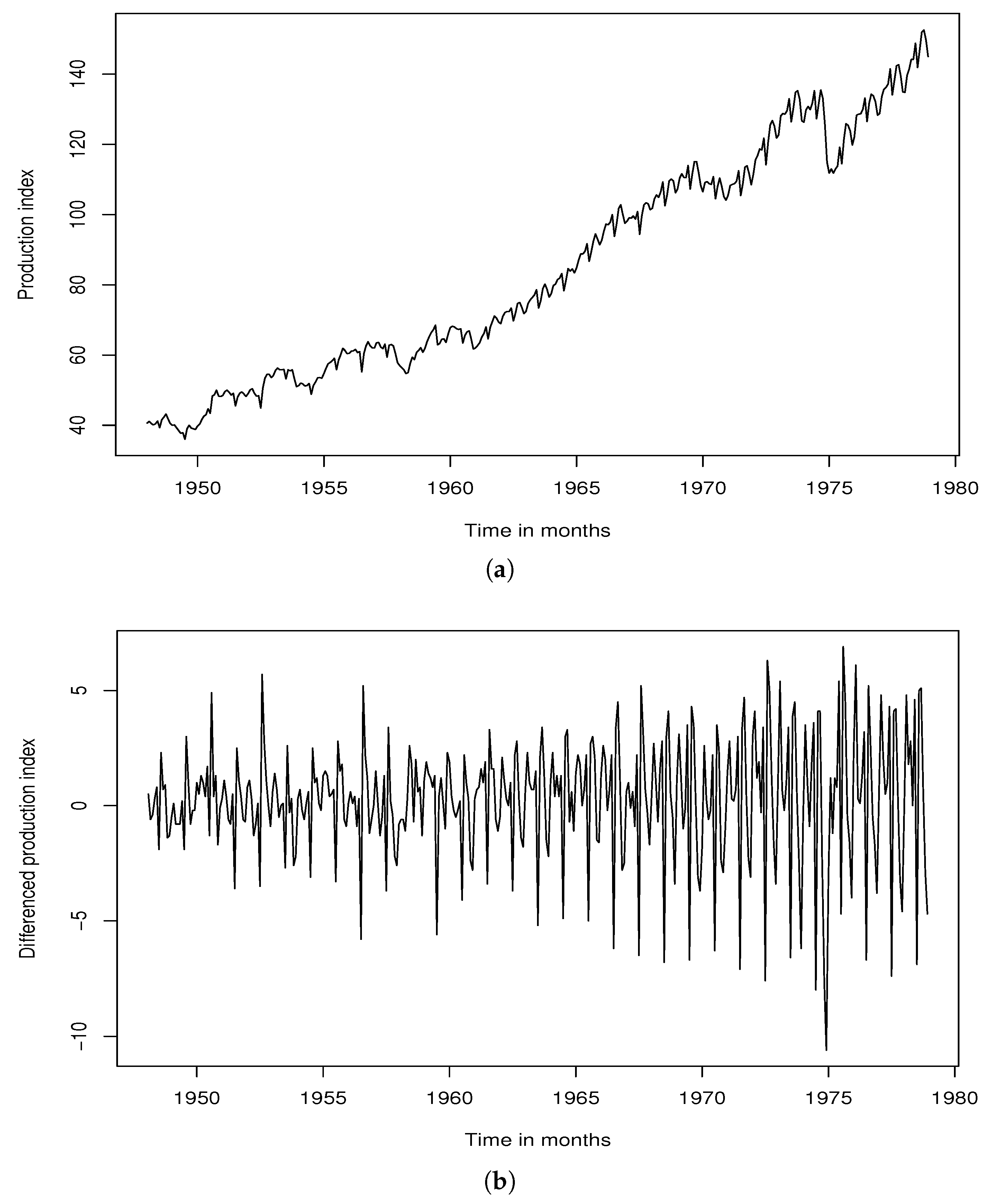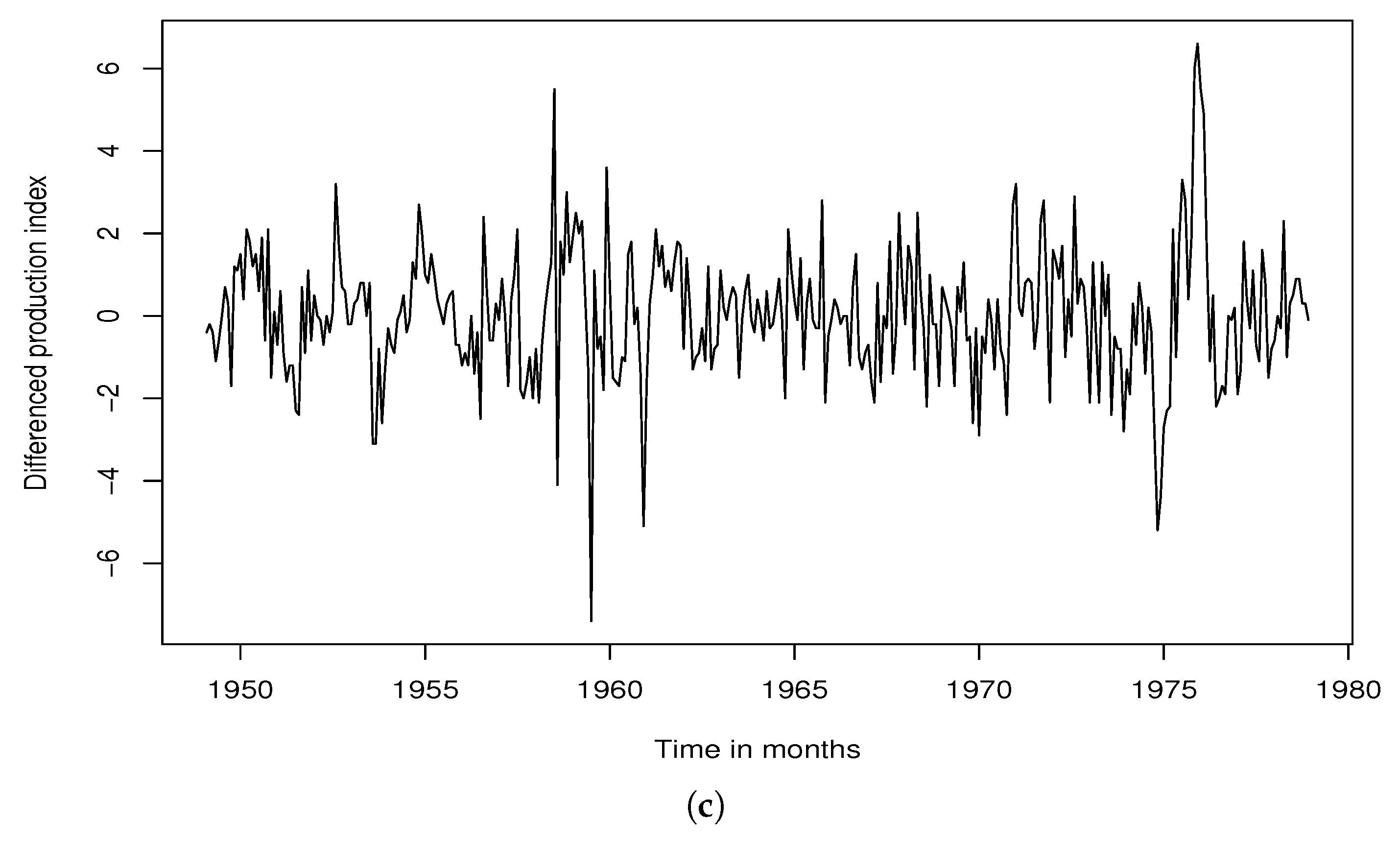1. Introduction
Seasonal autoregressive (SAR) time series models are widely used in different fields such as economics and finance to fit and forecast time series that are characterized by seasonality [
1]. As it is well known, time series modeling starts with the specification of the model order, followed by estimation, diagnostic checks, and forecasting [
2]. Therefore, the model specification phase is important, since all other modeling phases depend on its accuracy. In most real-world applications, the number of time series lags incorporated in a proposed time series model for an underlying time series is unknown, and this number of time series lags in this case is known as the model order, which needs to be specified or estimated based on the given time series data and its assumed probability distribution [
3].
Although the time series model order is usually unknown, a maximum value of this order can be assumed, and different methods can be introduced to select the best subset to have a parsimonious model. Traditional subset selection methods include information criteria, such as the Akaike information criterion (AIC) [
4] and the corrected AIC (AIC
) [
5]. These traditional selection methods use exhaustive searches based on parameter estimation and order selection. Many researchers have used these methods for subset selection in autoregressive (AR) time series models, including McClave [
6], Penm and Terrell [
7], Thanoon [
8], Sarkar and Kanjilal [
9].
However, it is very computationally expensive to apply these traditional methods to complicated models with high orders, such as the SAR models and other time series models with multiple seasonalities [
10,
11]. Accordingly, other subset selection procedures based on Markov chain Monte Carlo (MCMC) methods have been proposed for reducing the computational cost and efficiently selecting the best subset of time series models. Some researchers have adopted the stochastic search variable selection (SSVS) procedure, which was introduced by George and McCulloch [
12], for selecting the best subset of linear regression models to be applied to the subset selection of time series models. Chen [
13] proposed the Gibbs sampler, along with the SSVS procedure, to select the best subset of AR models. This work has been extended by different researchers to other time series models. So et al. [
14] extended it for the subset selection of AR models with exogenous variables, and Chen et al. [
15] extended it for the subset selection of threshold ARMA models.
On the other hand, the Bayesian analysis of the SAR model is complicated, because the likelihood function is a nonlinear function of the SAR model coefficients, and, accordingly, its posterior density is analytically intractable. Different approaches have been introduced to facilitate this analysis, including Markov chain Monte Carlo (MCMC)-based approximations [
16]. Barnett et al. [
17,
18] applied MCMC methods to estimate SAR and ARMA models based on sampling functions for partial autocorrelations. Ismail [
19,
20] applied the Gibbs sampler to introduce the Bayesian analysis of SAR and SMA models. Ismail and Amin [
16] applied the Gibbs sampler to present the Bayesian estimation of seasonal ARMA (SARMA) models, and, recently, Amin [
1] used the same approach to introduce the Bayesian prediction of SARMA models. For modeling time series with multiple seasonalities, Amin and Ismail [
21] and Amin [
22,
23] applied the Gibbs sampler to introduce the Bayesian estimation of double SAR, SMA, and SARMA models. Recently, Amin [
24,
25] applied the Gibbs sampler to introduce the Bayesian analysis of double and triple SAR models.
From a real-world application perspective, it is crucial to introduce an efficient Bayesian method for selecting the best subset of the SAR models, with the aim to obtain a parsimonious SAR model. However, most of the existing work has focused only on the Bayesian estimation and the prediction of SAR processes, and none of them has tried to tackle this problem of selecting the best subset of the SAR models. Therefore, in this paper, we aim to fill this gap and enrich real-world applications of the SAR models by introducing a Bayesian method for subset selection of these models based on modifying the SSVS procedure and adopting the Gibbs sampler. In particular, we first introduce latent variables for the nonseasonal and seasonal SAR model lags, assume that the SAR model errors are normally distributed, and employ mixture–normal, inverse gamma, and Bernoulli priors for the SAR model coefficients, variance, and latent variables, respectively. We then derive full conditional posteriors of the SAR model parameters in the closed form, and we apply the Gibbs sampler, along with SSVS, to develop an efficient algorithm for the best subset selection of the SAR models. In order to evaluate the performance of the proposed algorithm, we conduct a simulation study and a real-world application.
The remainder of this paper is organized as follows: We summarize the SAR models and related Bayesian concepts in
Section 2. We then introduce the posterior analysis and proposed algorithm for the Bayesian best subset selection of the SAR models in
Section 3. In
Section 4, we present and discuss simulations and the real-world application of the proposed Bayesian subset selection algorithm. Finally, we conclude this work in
Section 5.
2. Seasonal Autoregressive (SAR) Models and Bayesian Concepts
A mean deleted time series
is generated by a seasonal autoregressive model of order
and
, and is designated as SAR
if it satisfies [
2]:
where the SAR errors
are assumed to follow a normal distribution with a mean zero and variance of
,
s is the seasonal period, and
B is an operator defined as
.
and
are the nonseasonal and seasonal autoregressive polynomials with orders
and
, respectively. Also,
and
are the nonseasonal and seasonal autoregressive coefficients, respectively.
We can expand the SAR model (
1) and write it as follows:
With the objective of simplifying the Bayesian analysis, we write the SAR model (
2) in a matrix notation as follows:
where
,
, and
is an
matrix, i.e.,
, with the
row defined as:
and
is the coefficient vector, which is defined as the following:
The products of the coefficients, i.e., , are part of the SAR model, and, accordingly, this model is a nonlinear function of and , thereby leading to complications in its Bayesian analysis.
As we mentioned in the introduction, one of the main challenges of time series analysis is specifying the value of the SAR model order
and
, since these values are unknown and depend on the stochastic structure of the time series under study. Thus, we assume that the maximum value of the SAR model order is known, and we adopt and modify the SSVS procedure for the Bayesian best subset selection of the SAR model. Accordingly, we first introduce a latent variable for each coefficient of the SAR model, i.e.,
for
, where
equals to one when the corresponding time series lag to
is selected, and it equals to zero otherwise. We then represent the prior distribution on each SAR model coefficient
using a mixture–normal distribution that is defined as:
and
Thus, the prior distribution of
and
can be presented as a multivariate normal distribution that is defined as follows:
where
,
is a diagonal matrix, i.e.,
with
if
and
if
, and
is a prior correlation matrix. Here,
is specified in such a way to be a scaling of the prior covariance matrix to satisfy the prior specification in (
6). In particular, we chose
to be small, and, therefore, the
s associated with
would likely be close to zero. In addition, we chose
to be large enough to make
highly greater than
; thus, the
associated with
would tend to have a high variation and likely be away from zero, and the corresponding time series lags were selected as the best subset SAR model. For more information about setting these constants in the SSVS procedure, we refer to George and McCulloch [
12].
As a prior distribution of
, we specify an inverse gamma distribution that is defined as:
Using the marginal distribution of the
s given in (
7), we can write the joint prior distribution of
as:
It is worth noting that the uniform prior of
, i.e.,
, is a special case, since each time series lag has the same probability to be selected.
The likelihood function of the SAR model (
3) with normally distributed errors can be presented as:
We can obtain the joint posterior distribution of the SAR models by simply multiplying the prior distributions given in (
8)–(
10) by the likelihood function given in (
11), which can be presented as:









